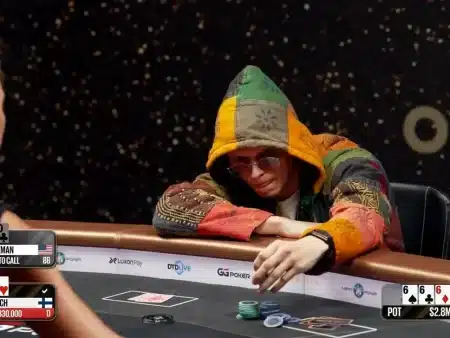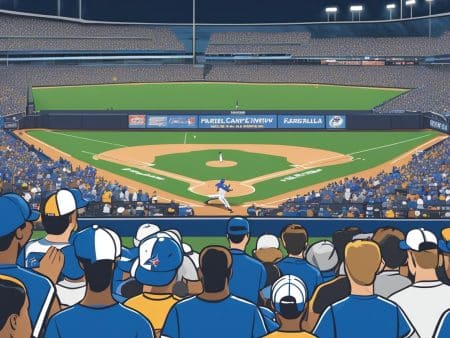Playing the late stages of poker tournaments is a whole different animal compared to the early rounds. Once the field shrinks to under 20% of players and the money bubble looms, you’ve got to start making some serious adjustments.
Getting a grip on push/fold ranges and the ins and outs of ICM is pretty much non-negotiable if you want to consistently run deep in multi-table tournaments.

The pressure ramps up late when stack sizes get thin and blinds shoot up fast. You have to walk the line between aggression and survival, always on the lookout for spots to chip up without putting yourself at unnecessary risk.
This balancing act never really stops shifting. Stack sizes, table personalities, and the looming pay jumps all mess with the math and the mood.
If you watch the players who always seem to find themselves at final tables, you’ll notice they lean hard on fundamentals when stacks are short. They know when to slam on the brakes near pay jumps, and when to go full throttle against opponents who are just hanging on.
It’s these little adjustments that keep them in the hunt, rather than just min-cashing and calling it a day.
Understanding Late Stage MTT Dynamics

Late-stage tournament play is a whole different ballgame. The blinds start to bite, stacks get all over the place, and suddenly every decision feels like it could make or break your run.
You’re creeping up on the money and the final table, and the weight of each move just keeps increasing.
Transitioning from Early to Late Stages
In the early goings of an MTT, you can take your time and pick your spots. But as things get serious, that luxury goes right out the window.
You have to shift from just stacking chips for fun to actually thinking about survival and climbing the ladder. The ranges you play open up a lot.
Hands you’d toss in the muck early on might suddenly become solid shoves or calls. Position? It gets way more powerful, especially when stealing blinds becomes a lifeline.
One of the most important tweaks is knowing when to switch gears into ICM-aware mode. Usually, that’s when the big pay jumps are coming up or you’re on the brink of the final table.
At this point, you can’t just think in chips—you’ve got to think about how every action affects your shot at the real money.
Changes in Blind Structure and Antes
Blinds and antes don’t mess around late in a tournament. They can leap by 50-100% in a single level, and suddenly even a decent stack starts to feel tiny.
Antes alone can make up 15-30% of the preflop pot, so stealing those blinds gets really lucrative—even with hands you’d usually ignore. The big blind ante has only made this more intense.
You need to keep an eye on your blind-to-stack ratio. If the blinds are chewing up more than 10% of your stack, you’re basically in push-or-fold mode for a lot of hands.
It’s less about reading people and more about the math at that point.
Blind structure also changes how folks play the bubble. Fast structures crank up the pressure and the variance, while slower ones give you a bit more room to maneuver around pay jumps.
Impact of Stack Sizes on Strategy
Everything in the late stages revolves around stack sizes. If you’ve got 20+ big blinds, you can really lean on those with less—especially the folks clinging to tournament life.
Medium stacks (10-20 big blinds) have to walk a tightrope. They should be looking for spots to reshove over aggressive openers, especially when the big stacks are pushing people around.
If you’re down to under 10 big blinds, it’s time for push-or-fold. Not a lot of room for fancy stuff—just find a spot to get your chips in first, ideally against someone who doesn’t want to risk it all.
And don’t forget, the way chips are spread out at your table changes everything. A table full of shorties plays way differently than one with everyone evened out.
Adjust your opening hands based on who’s left to act and their stacks.
Key Strategies for Late Stage Success
When you’re deep in a tournament, you can’t just coast. Your stack, position, and how your opponents are acting suddenly matter a whole lot more, especially now that the big money is in sight.
Stealing the Blinds Effectively
Blind stealing is basically survival at this point. Look for those golden opportunities when it folds to you in late position, especially with tight players sitting in the blinds.
Pay attention to who’s hurting for chips. Players with 10-15 big blinds are usually just trying to hang on, so they’re not calling light. They’re your best targets.
Your table image counts, too. If you’ve been caught stealing a few times, mix in some value hands from late position to keep people guessing.
Stick with a solid raise size, like 2-2.5x. It keeps your risk down and your fold equity up. If someone fights back and you’re holding air, don’t be afraid to just let it go.
Applying Aggressive Play
Aggression is the name of the game late, but you’ve got to pick your spots. Zero in on those passive medium stacks who are just trying to ladder up, and keep hammering them.
When to dial up the aggression:
- You’ve got 20+ big blinds
- You spot opponents who are way too tight
- You’ve been playing tight yourself and can use your image
- Big pay jumps are right around the corner
Don’t get into it with the chip leader unless you’re holding the goods. They can afford to splash around and see flops, which kills your fold equity.
Well-timed 3-bets work wonders against other thieves at the table. Sometimes you can scoop big pots without ever seeing a showdown, and it lets everyone know you’re not to be messed with.
Navigating Tight Tables
Late in a tournament, everyone starts to clam up because of the pay jumps. That’s your cue to get a little more aggressive—selectively, of course.
Position is gold on a tight table. From late position, you can open up your range and pick up a lot of uncontested pots.
How to adjust for tight tables:
- Open wider, especially from the button or cutoff
- Shrink your continuation bets a bit
- Isolate short stacks when you get the chance
- Be ready to back off if someone suddenly wakes up and fights back
Watch for players who flip the switch from tight to suddenly hyper-aggressive. More often than not, they’re sitting on a real hand.
When short stacks start shoving, tighten your calling range. Their pushing range gets wider, but you still can’t call as loose as you would in a cash game.
Stack Size Management and Adjustments
Your stack in the late stages pretty much dictates your options. Savvy players know how to shift gears depending on whether they’re short, deep, or somewhere in the middle, and they adjust their hand selection and aggression on the fly.
Short Stack Play and Survival
If you’re under 15 big blinds, you’re in the danger zone. Your mission now is to find a spot to double up—not to bleed out slowly.
Look for those push/fold spots where you can get it in with positive EV. Pocket pairs and strong Ax hands go up in value, but forget about suited connectors—you just can’t afford to see flops anymore.
Keep an eye on your “M-ratio” (stack divided by total blinds and antes per orbit). If you’re under 10, it’s time for all-in or fold. Don’t waste chips with small raises that leave you pot-committed but still able to fold.
You need patience, but not too much. Blinds force your hand, so target loose callers who might pay you off with worse.
Big Stack Pressure Tactics
With 40+ big blinds, you’re the table boss. Use that leverage against players who don’t want to tangle with you.
Attack unopened pots from late position and make everyone think twice about messing with you. The ICM pressure is real—other players have to worry about pay jumps while you can just keep applying heat.
Big stack moves:
- Open wider from late position
- Re-steal from regulars who are getting out of line
- Isolate short stacks with a broad range
- 3-bet light against medium stacks who can’t push back
Don’t get too cute. The real power in a big stack is steady pressure, not wild bluffs or fancy plays that could blow up in your face.
Playing Medium Stacks Effectively
Medium stacks (15-40 big blinds) are tricky. You’ve got enough chips to do more than just shove or fold, but not enough to bully everyone.
Pot control is important, and you want to pick your spots carefully. Against short stacks, don’t get involved unless you’re strong. Against the big stacks, avoid those marginal spots where you could lose it all.
Look for:
- Steal chances from late position
- Re-steal spots against frequent openers
- Three-bet value with strong hands
- Good spots to flat call with hands that play well postflop
It’s a balancing act—chip up without risking your tournament life. The goal is to work your way into a big stack so you can really start pushing people around.
Optimizing Decisions for Tournament Advancement
Making the right calls in the clutch is what separates the grinders from the rest. The best players combine math with a read on the table vibe to squeeze every bit of value out of their stack.
Adapting to the Final Table
Final table play is a different beast. Stack sizes are on display, and you’ve got to adjust fast.
If you’re in the middle, it might be time to get aggressive against the shorties, but you don’t want to mess with the big stacks unless you have to.
ICM is king here. Every decision needs to factor in what each chip is really worth, not just in chips but in actual dollars.
Late position is even more valuable now. You can pick on the weak spots and steal blinds more often. Most players tighten up as the payouts get serious.
Sometimes, making a deal makes sense. If someone brings up a chop, know your equity and don’t be afraid to negotiate if it gets you a better payday.
Reading Table Dynamics
People change as the pressure builds. Watch for shifts—some tables get super tight, which is great for stealing. Others get wild, with players taking big risks.
Figure out who’s playing to win and who’s just trying not to lose. That tells you how much pressure you can put on them.
Stack distribution matters, too. A table with a bunch of short stacks opens up different opportunities than one where everyone’s about even.
Handling Variance and Pressure
Variance is just part of the package late in tournaments. Blinds force action and all-ins become unavoidable.
Mental game reminders:
- Take a breath between hands
- Focus on making good decisions, not the results
- Don’t let the pressure change your process
- Accept that bad beats happen—sometimes you just can’t dodge them
Physical stuff matters, too. Stay hydrated, stretch if you can, and keep your head in the game.
After the tournament, look back at your tough spots. That’s where you really get better at handling the heat next time.
Targeting Dead Money Players
“Dead money” players are those who are just trying to hang on or are making big mistakes. Spotting these folks and going after them is a huge edge.
Look for players who:
- Fold to any pressure
- Only play monsters
- Look nervous or uncomfortable
- Are clearly out of their comfort zone, maybe playing higher stakes than usual
Attack them when you’re in position. Raise their blinds, keep the pressure on, and force them into mistakes.
Be patient, though. Eventually, most of these players will panic and shove light, giving you the chance to snap them off with a real hand.
A lot of tournament players overvalue just surviving. That’s exploitable—don’t be afraid to go after those chips.
Avoiding Common Mistakes and Elevating Your Game
Even good players can trip up late in tournaments. Usually, it’s because they misread the payout structure or start thinking it’s all about luck instead of skill.
Recognizing and Correcting Costly Errors
One of the biggest mistakes is getting too passive with a medium stack. The fear of busting just before the money can freeze you up and cost you big opportunities.
Another misstep is not changing your bet sizes as stacks get shorter. If you keep using the same bets as when you were deep, you’re missing the point of the late-game dynamics.
People also get stuck playing too many hands from early position. Late in the game, position is everything—don’t give away chips when you don’t have to.
Small pairs and suited connectors? They lose a lot of value when you’re short and the blinds are huge. Don’t overplay them.
Understanding Payout Structure Importance
How the tournament pays out changes everything. Each pay jump is real money, and you have to factor that into every decision.
Most tournaments are top-heavy, so the difference between spots is huge. If you know what’s at stake, you can make better ICM-based choices.
With a medium stack, sometimes folding a marginal hand is the right call if it means moving up the ladder. Don’t chase every pot if the math says it’s not worth it.
Short stacks, especially, need to know when to push and when to hold back based on the next payout jump. That’s where a lot of the edge comes from.
Focusing on Skill Level Over Luck
Yeah, luck is part of the game, but the best players make their own luck by making better decisions over and over. Focus on improving your choices, not just the outcome.
Go back and look at your sessions. Where did you lose big pots? Were those decisions actually good, or did you just get unlucky?
Work on all aspects of your game—aggression, defense, shifting gears when the table changes. The more tools you have, the better you’ll adapt.
And don’t underestimate mental toughness. Staying sharp, not tilting after a bad beat, and grinding through long sessions—that’s what keeps you in the hunt.
Comparing MTT Strategies Across Formats
Tournament poker is never one-size-fits-all. Different formats, stakes, and stages all require their own tweaks.
The best players are always adapting, always looking for new edges, and never afraid to use whatever tools give them an advantage.
Differences Between MTTs and Cash Games
MTT strategy really isn’t the same as cash game strategy, and there are some pretty big differences. In cash games, you’ll notice players usually open with tighter ranges because stack depths just don’t change.
For example, the button opens around 42% of hands in cash games, but that number jumps to 53% in MTTs. That’s a pretty significant gap if you ask me.
As tournaments move along and blinds keep rising, play gets a lot more aggressive. Stack sizes shrink, so there’s this constant pressure to build your stack—especially late on.
In cash games, you can just rebuy whenever you want, so busting out isn’t really a thing. In tournaments, though, when you’re out, that’s it. That survival factor really messes with your decisions.
Position gets even more important in tournaments. Playing from the cutoff or button becomes a goldmine for stealing blinds once antes are in the mix.
Transitioning from Low Stakes Poker
Jumping from low stakes to higher MTTs? That’s a whole different animal. At the lower levels, you’ll run into a lot of passive players who just fold too much when faced with aggression.
As you move up, though, opponents get sharper. They actually understand stuff like ICM pressure and won’t just roll over. You’ll need to get creative with your bluffs and value bets.
Key adjustments include:
- Tightening up your preflop ranges early on
- Ramping up your 3-bet frequency against those aggressive regulars
- Working on strategies for both short and deep stacks
- Really paying attention to how the table’s playing
A lot of low stakes players let chances slip by in bubble situations. If you want to move up, learning to use ICM to your advantage is just non-negotiable.
Using a Poker Cheat Sheet for Late Stages
A solid poker cheat sheet can really make a difference when you’re deep in a tournament. Sometimes, you just need a quick refresher to make the right call under pressure.
These tools are handy for all sorts of late-stage situations. For example:
- Push/fold charts for short stack play (under 15BB)
- Defensive calling ranges from the big blind
- ICM-adjusted shoving ranges near the bubble
- Final table payout considerations
A lot of top players actually look over these resources between tournaments, hoping to lock in the right habits. These days, you’ll find that the best cheat sheets are packed with GTO solver data tailored to specific tournament setups.
It’s worth noting that rising blinds and antes can create some pretty wild pressure points as you get closer to the end. If your cheat sheet doesn’t take those into account for each position, well, it’s probably time for an upgrade.













